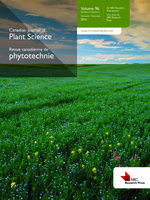Izydorczyk, M. S., McMillan, T., Bazin, S., Kletke, J., Dushnicky, L., Dexter, J., Chepurna, A. and Rossnagel, B. 2014. Milling of Canadian oats and barley for functional food ingredients: Oat bran and barley fibre-rich fractions. Can. J. Plant Sci. 94: 573-586. Oats and barley are recognized for their valuable fibre constituents having protective and therapeutic effects against the development of diet-related disorders. Mixed linkage (1-3), (1-4)-β-D-glucans, the major dietary fibre constituents in oats and barley, have been linked to blood cholesterol lowering properties of these grains. The objective of this study was to compare oat bran and barley fibre-rich fractions (FRF) as two products with elevated levels of β-glucans and obtained by similar roller milling processes. The content of β-glucan in oat brans prepared from three different cultivars (AC Morgan, HiFi, and CDC ProFi) ranged from 7.90 to 9.50%, whereas the content of β-glucans in FRF prepared from three barley cultivars (CDC McGwire, CDC Fibar, and CDC Hilose) ranged from 9.31 to 18.19% (dwb). The yields of oat brans ranged from 44 to 49% and the yields of barley FRF from 39-49%. Both preparations contained higher amounts of arabinoxylans, proteins, and ash compared with the original grains. The oat brans were made up mainly of fragments containing the outer grain layers with a substantial portion of the subaleurone starchy endosperm attached to them, whereas the barley FRF consisted primarily of fragments containing the endosperm cell walls, with a smaller proportion of the outer grain tissues. The barley FRF contained smaller particles with broader distribution of particle size than the oat brans. The oat bran particles had higher bulk density and lower porosity than the barley FRF. Both preparations showed pronounced viscosity-building properties when dispersed in water at 45°C, but exhibited different viscosity profiles and differences in the attainable viscosity values.
How to translate text using browser tools
10 December 2013
Milling of Canadian oats and barley for functional food ingredients: Oat bran and barley fibre-rich fractions
Marta S. Izydorczyk,
Tricia McMillan,
Sharon Bazin,
Jerry Kletke,
Len Dushnicky,
James Dexter,
Anna Chepurna,
Brian Rossnagel
ACCESS THE FULL ARTICLE
It is not available for individual sale.
This article is only available to subscribers.
It is not available for individual sale.
It is not available for individual sale.

Canadian Journal of Plant Science
Vol. 94 • No. 3
March 2014
Vol. 94 • No. 3
March 2014
avoine
barley
barley fibre
bêta-glucanes
beta-glucans
fibres d'orge
milling




